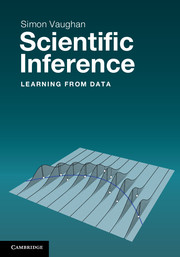Book contents
- Frontmatter
- Dedication
- Contents
- For the student
- For the instructor
- 1 Science and statistical data analysis
- 2 Statistical summaries of data
- 3 Simple statistical inferences
- 4 Probability theory
- 5 Random variables
- 6 Estimation and maximum likelihood
- 7 Significance tests and confidence intervals
- 8 Monte Carlo methods
- Appendix A Getting started with statistical computation
- Appendix B Data case studies
- Appendix C Combinations and permutations
- Appendix D More on confidence intervals
- Appendix E Glossary
- Appendix F Notation
- References
- Index
Appendix A - Getting started with statistical computation
Published online by Cambridge University Press: 05 June 2014
- Frontmatter
- Dedication
- Contents
- For the student
- For the instructor
- 1 Science and statistical data analysis
- 2 Statistical summaries of data
- 3 Simple statistical inferences
- 4 Probability theory
- 5 Random variables
- 6 Estimation and maximum likelihood
- 7 Significance tests and confidence intervals
- 8 Monte Carlo methods
- Appendix A Getting started with statistical computation
- Appendix B Data case studies
- Appendix C Combinations and permutations
- Appendix D More on confidence intervals
- Appendix E Glossary
- Appendix F Notation
- References
- Index
Summary
Dotted throughout the book are extracts of computer code that show how to perform the calculations under discussion. The examples are based on specific problems discussed in the text, but should be clear enough that they can also be used, with very little effort, for ‘real life’ data analysis problems. The computer codes are written in the R environment, which is introduced in this appendix.
What is R?
R is an environment for statistical computation and data analysis. You can think of it as a suite of software for manipulating data, producing plots and performing calculations, with a very wide range of powerful statistical tools. But it is also a programming language, so you can construct your own analyses with a little programming effort. It is one of the standard packages used by statisticians (professional and academic). To install R visit www.r-project.org/.
A first R session
First of all, start R, either by typing R at the command prompt (e.g. Linux) or double-clicking on the relevant icon (e.g. Windows).
A typical R session involves typing some commands into a ‘console’ window, and viewing the text and/or graphical output (which may appear in a pop-out window). The prompt is usually a ‘>’ sign, but can be changed if desired. At the prompt you can enter commands to execute.Virtually all commands in R have a command(arguments) format, where the name of the command is followed by some arguments enclosed in brackets (if there are no arguments the brackets are still present but empty).
- Type
- Chapter
- Information
- Scientific InferenceLearning from Data, pp. 185 - 194Publisher: Cambridge University PressPrint publication year: 2013



